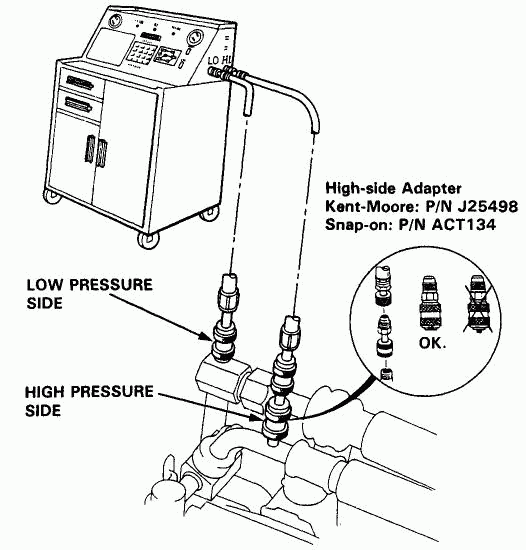ВНИМАНИЕ! График работы на майских праздниках: Офис в Москве: 9 мая ВЫХОДНОЙ!
Офис в СПБ: 1 мая, 9 мая - ВЫХОДНОЙ!
A/C System Service
Leak Test
AWARNING When handling refrigerant (R-12):
• Always wear eye protection.
• Do not let refrigerant get on your skin or in your eyes. If it does:
- Do not rub your eyes or skin.
- Splash large quantities of cool water in your eyes or on your skin.
- Rush to a physician or hospital for immediate
treatment. Do not attempt to treat it yourself.
• Keep refrigerant containers (cans of R-12) stored
below 40°C (100°F).
• Keep away from open flame. Refrigerant, although non-flammable, will produce poisonous gas if burned.
• Work in a well-ventilated area. Refrigerant evaporates quickly and can force all the air out of a small, enclosed area.
IMPORTANT: Do not vent refrigerant to the atmosphere. The chlorofluorocarbons (CFCs) used in conventional refrigerant (R-12) may damage the earth's ozone layer. Always use UL-listed, refrigerant recovery/recycling equipment to extract the refrigerant before you open an A/C system to make repairs. Follow the equipment manufacturer's instructions.
1. Attach an Air Conditioning Service Station as shown.
NOTE: Connect the adapter to the high pressure hose first, then connect the hoses to the car as shown. When testing is completed, disconnect the hose adapter from the high-side fitting; do not disconnect the hose from the adapter, or refrigerant may escape from the system.
2. Open high pressure valve to charge the system to about 100 kPa (14 psi), then close the supply valve.
3. Check the system for leaks using an electronic leak tester.
Follow the manufacturer's instructions.
5. After checking and repairing leaks, the system must be evacuated (see System Evacuation on page 22-33).

О компании
Каталоги
Каталоги авто
Наши телефоны:
Наши реквизиты:
Политика конфиденциальности
2024, HondaWorld.
Все права защищены
Наши реквизиты:
ООО "ПартсРу"
ИНН 7713747944, КПП 774301001
ОГРН 1127746372401
ИНН 7713747944, КПП 774301001
ОГРН 1127746372401
Политика конфиденциальности
2024, HondaWorld.
Все права защищены






